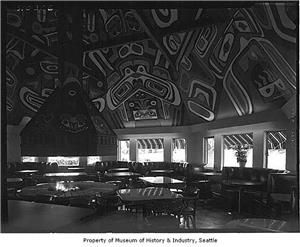On March 13, 1937, the Twin T-Ps (later Power's Pancake House and Twin Teepees) opens at 7201 Aurora Ave. N, near Green Lake. The unusual building features two metal-clad conical pavilions, hence its name, intended to attract the attention of passing motorists, and becomes an instant, if unofficial, landmark. Such structures, now rare in Seattle, are classified as "vernacular architecture" because their idiosyncratic designs usually reflect individual quirks or promotional strategies rather than conventional standards.
The building was designed by Delland Harris and housed the main dining room was housed in the southern "teepee." A pre-opening article in The Seattle Times described its dining room as featuring "a huge open-pit fireplace, covered with seashells" in a decor inspired by American Indian designs. The northern pavilion contained the kitchen and a cocktail lounge. Restrooms were located on the upper floor of a lobby structure bridging the two teepees.
Twin Teepees' fare consisted of standard American dishes. Prime rib became a popular Friday night specialty in the 1980s and 1990s.
A Colonel in the Kitchen
The Twin T-Ps was first operated by Herman E. Olson. It passed through several hands before being acquired in 1942 by Walter Clark (d. 1990), who went on to build a regional chain of 22 restaurants. Clark employed a former war buddy, Col. Harland Sanders, who worked on his famous "Kentucky fried chicken" recipe in the Teepee's kitchen before establishing his own fast food empire (Tippetts).
The restaurant operated as "Powers Pancake House" between 1959 and 1967. Its original name was restored, although spelled out as "Teepees" in 1976. The restaurant suffered a fire on July 31, 1997, and a more serious blaze on June 1, 2000, closed its doors.
On July 31, 2001, early in the morning, the restaurant was bulldozed to the ground, despite its place in Seattle's history and despite the fact that it would have undoubtedly been protected under historic preservation. Landlord Rob Pierides explained that it was too complex and expensive to repair.

